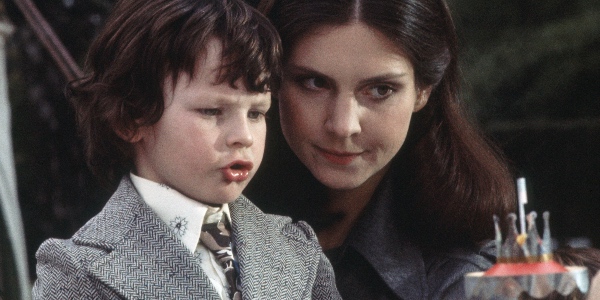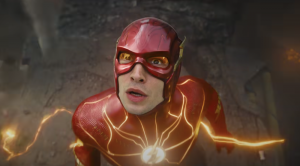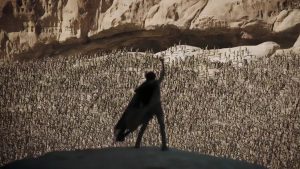
Welcome back to the scariest, and at times goriest, column here at Film Inquiry: Horrific Inquiry. Twice a month, I will be tackling all things horror, bringing two films back into the spotlight to terrify and frighten once more. And occasionally looking at those that could have pushed the envelope further. Join us as we dive deep into the heart of horror, but warning, there will be spoilers.
The Omen has been on my list for a long time. Having seen the remake when it was released on June 6, 2006, there was always a desire to watch Gregory Peck fight the rise of evil. With Easter just around the corner, it felt like the perfect time to check this one off my list.
The opening sequence is eerie, the ominous choral music filling viewers with dread as the screen displays its opening credits and a stand alone shadow image of a small boy, his shadow creating a cross. There is a sense of dominance, the silhouetted child remaining above the cross, the film’s refusal to move from this image delivering a devastating sense of foreshadowing – evil always wins.
Setting the Antichrist in Motion
The Omen opens in Rome on June 6th at 6am, Robert (Gregory Peck) arriving at the local hospital. His wife Kathy (Lee Remick) had gone into labor, and to his devastation, the child had not survived. As he considers the blow this will be to his wife, Father Spiletto (Martin Benson) begins to suggest that he could adopt, another child born that night having lost his mother in child birth. Robert is hesitant, yet the film moves quickly to show his acceptance of the idea.
The Omen is film filled with deeply constructed representational shots. There impact is undeniable and the the beauty of their craft breathtaking. Here, as Robert is shown the child, the moment takes on a sense of double exposure – a double truth. Robert is shown the child through the nursery window, the innocence and need of the child radiating and solidifying Robert’s decision to call him his own. In the background however, Father Spiletto moves in the distance, settling in the corner and looking back on the scene. If you know the story of The Omen, the shot speaks even louder, the puppeteer looking back at his construction, the final strings of his involvement being pulled. It is a powerful image, one that finds its match as Father Brennan is introduced later on.
source: 20th Century Fox
The Omen works swiftly to move through the next five years. Robert is promoted to Ambassador in London and the love of a family is deeply shared between them. There is little dread or foreshadowing in these moments, giving viewers a false sense of security. It is as though it is the calm before the storm. And like most evil, it does not come with a bang but with a whisper. As Kathy and Robert celebrate Damien’s (Harvey Stephens) fifth birthday, a day of joy quickly descends into terror. As Kathy takes her son back from the nanny (Holly Palance), the nanny catches sight of a dog in the distance a quiet dialogue occurs between them. It is the whispers that possess her, the nanny seen moments later calling out to Damien – “Damien look at me. It’s all for you Damien” – before leaping from top of the manor, the rope around her neck breaking her fall and her body crashing through a window.
The Omen is surprisingly gory, with beheadings, impalements, hangings and tragic falls captured straight on – the body count of The Omen almost never looking away. I was surprised with each death, knowing who was to die less shocking than how it was displayed on screen. The remake in many instances worked almost shot for shot from the original, so there were few surprises along the way. But the gore – this one will stick with me for some time.
source: 20th Century Fox
I was shocked at the brutality of the hanging, both for the time period the film was released and in how real it felt. The nanny does not just drop and hang there, rather as the body of the nanny swings through window, becoming a representation of the momentum her death has caused. The chess pieces for years have been put in place, and with her death, the rise of the antichrist is set into motion.
“‘Til man exists no more”
Following the death of the nanny, Father Brennan (Patrick Troughton) is introduced. Once a willing participant in the chess match at hand, Father Brennan seeks to find his redemption and forgiveness. He arrives at the embassy attempting to warn Robert of the dangers that are headed for his family. Again, The Omen embraces the craft of the perfect shot, Father Brennan appearing on the right of the screen as he enters Robert’s office. The shot is positioned from Robert’s desktop, an image of Kathy and Damien in the forefront, Father Brennan’s positioning to the right seemingly above them. It works with the earlier shot of Father Spiletto as Robert adopts Damien. The Omen crafts a dueling set of images here, almost a devil and angel on Robert’s shoulder, each working to manipulate the momentum of the rising antichrist.
source: 20th Century Fox
Father Brennan however seems nothing more than insane, a security threat even. He is escorted from the embassy, however his rants and ravings linger over the film. As The Omen moves forward, Mrs. Baylock (Billie Whitelaw) arrives to become Damien’s new nanny, immediately radiating deeper intentions. Additionally, Kathy begins to experience thoughts and feelings that Damien is not her child. Seeking psychiatric help, the film begins to unravel into madness, with the rise of the antichrist calling the shots.
When I told my father I would be watching The Omen for the first time, his excitement fell on the death of the photographer Jennings (David Warner). Having watched the remake, I expected his death well as the death of Father Brennen. What I did not expect was the execution that would follow. As mentioned, the gore was one of the most impressive aspects of The Omen. As Father Brennan delivers his final warning to Robert, foreshadowing the pregnancy and death of Kathy and the rise of the antichrist, his warning comes with deadly consequences. The devil is everywhere and unforgiving. As Robert leaves Father Brennan in the park, a storm descends, The Omen once again embracing the beauty of the shot. As the camera pulls out, the storm increasing and lightning just missing Brennan, the grandeur and scope of evil is encompassed in the long shot, Father Brennan becoming smaller and smaller in its wake. As he races to a nearby church he is shut out, the film seemingly crafting the feeling that the Lord has turned on Brennan as he once did to the Lord.
source: 20th Century Fox
There is no escape for the comeupence of the past and Father Brennan meets his end as he is impelled by a spire that falls from the top of the church. Shot for shot this was in the remake, however I had expected the camera to look away. Rather, it holds steady, taking in every moment of Brennan’s death. It is intense and brutal the build-up and final execution a moment in horror. From the nanny to Father Brennan, the momentum of The Omen continues to build.
The Prophecy Fulfilled
As Robert begins to accept the prophecy of the antichrist and the signs that are unfolding before him, Kathy is next to feel the wrath of evil. Fulfilling the predictions of Father Brennan, it is revealed that Kathy is in fact pregnant. As she expresses her desire to abort the child, Robert’s belief in the evil descending upon them grows. While he is determined to ensure the pregnancy comes to full term, his attempts to thwart the foreboding words of Father Brennan are futile. With the encouragement of Mrs. Baylock, Damien rides takes his scooter down the halls of their home, knocking Kathy over the balcony to the floor below. With the pregnancy lost and Kathy severely injured, Robert finds he must begin to heed Father Brennan’s prophecy and seek the tools to destroy the antichrist – before it is too late.
source: 20th Century Fox
From this moment on, The Omen goes into over drive. Kathy is killed by Mrs. Baylock, her body falling from a hospital window into a van below. Again the camera does not look away, following her fall to its inevitable conclusion, the doors of the van she falls into opening to show Kathy dead inside. As more aspects of Father Brennan’s prophecy come true, Robert’s time is running out. Accompanied by Jennings, Robert works to understand what happened the night of Damien’s birth, hoping an understanding can give disillusion all the warning signs that are rising.
Jennings’ death is a highlight of the film. While Robert struggles to accept and commit to what must be done, Jennings, who has had his own death prophicized in his photographs, is resolved to brings about Damien’s death. While Robert refuses to kill Damien and throws the knives in an alley, Jennings runs after them determined to bring an end to it all. Little does he know it is the end of him. As the scene unfolds, it feels like a deeply rooted inspiration for Final Destination, the unseen hand of death bringing about the brutal end to Jennings. As a construction truck begins rolling down the hill, one of the glass plates flies loose, beheading Jennings. It is a beautifully epic craft of gore, the camera refusing to look away as the glass cuts straight through, Jennings’ head bouncing in the aftermath. My father was right, one of the best scenes in the film.
Conclusion
With the death of Jennings, Robert becomes resolute to carry out the ritual to kill Damien. Upon returning home, he outsmarts the dog protecting Damien and defeats Mrs. Baylock to drag the boy away to the church. As instructed he brings out the knives to stab Damien, but defies the prophecy and words of Father Brennan one last time – he hesitates. As Damien takes on a look of innocence, crying” No Daddy! No” Robert pauses – long enough for the police to arrive and shot him. It is one of the only deaths we do not see on screen, the film transitioning to the burials of both Robert and Kathy. The film has built up to such an intensity, the transition feels jarring and sudden, especially as we do not see the aftermath of the police shooting. But we understand what has happened.
As mourners leave the coffins, a new figure is addressed as Mr. President, the final horror of Robert’s aftermath coming into focus. As the camera moves from the backside of the President, we see the young child standing beside him, Damien turning to viewers, seemingly breaking the fourth wall, his smile acknowledging not only his success but our bearing witness to his continued rise within the poser of American politics. It is a powerful final image, not only setting the film up for its inevitable sequel, but leaving viewers in the horrific realization that the antichrist has risen.
Does content like this matter to you?
Become a Member and support film journalism. Unlock access to all of Film Inquiry`s great articles. Join a community of like-minded readers who are passionate about cinema – get access to our private members Network, give back to independent filmmakers, and more.






